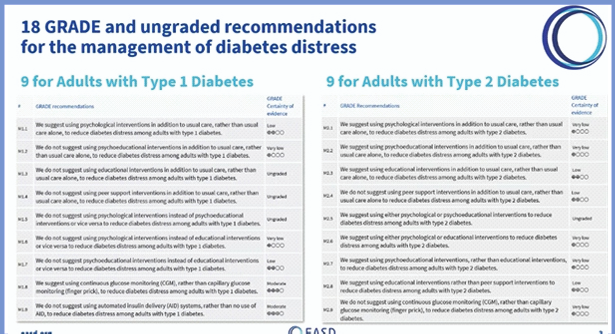
Introduction to Diabetes Distress:
Addressing the emotional side of diabetes and its management has received considerable attention in recent years. At the centre of most of these efforts is the concept of ‘diabetes distress’, a generic term that captures the primary sources and intensity of emotional distress associated with diabetes and its management over time. Karin Kanc discussed the recommendations for the clinical management of diabetes distress. The findings were presented at the EASD Annual th st Meeting 2025, held from 15 -19 September 2025 in Vienna, Austria.
Key Clinical Questions for HCPs:
One of the recommendations is to use psychological interventions in addition to usual care, rather than usual care alone, to reduce diabetes distress among adults with type 1 diabetes. This can have a small but beneficial effect in reducing diabetes distress, should be acceptable to adults living with type 1 diabetes & may promote health equity & is consistent with values that prioritise emotional well-being.
Role of Continuous Glucose Monitoring (CGM):
Another recommendation is continuous glucose monitoring (CGM), rather than capillary glucose monitoring (finger prick), to reduce diabetes distress among adults with type 1 diabetes. It is acceptable inspite of alarm fatigue and data overload, is feasible and cost-effective (in certain populations) though more research is needed. The suggestion was not to use automated insulin delivery (AID) systems, rather than no use of AID, to reduce diabetes distress among adults with type 1 diabetes.
Management Recommendations for Type 2 Diabetes:
In type 2 diabetes too suggestion was to use psychological interventions in addition to usual care, rather than usual care alone, to reduce diabetes distress among adults with type 2 diabetes. Also the recommendation was to use educational interventions in addition to usual care, rather than usual care alone, to reduce diabetes distress among adults with type 2 diabetes.
The recommendation summary should be an inspiration for Clinical Practice & also assessing what does the Guideline means to a clinician. Clinical management of diabetes distress involves regular emotional assessment using screening tools, followed by a person-centered approach to identify specific stressors and develop a tailored management plan. A holistic approach that addresses social and psychological factors, along with promoting self-care and resilience, is crucial for improving emotional well-being and diabetes outcomes.

